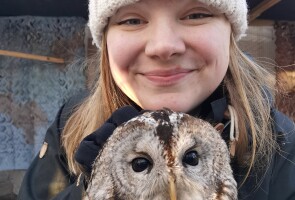New study by the University of Turku and Cornell University shows that long-term elimination of herbivorous insects from plants changes the way they communicate with each other. The study focused on Solidago altissima, i.e. tall goldenrod, and indicated that communicating about threats also benefits the plant sharing the information. Different communication strategies between plants can be explained with the differences in the volatile organic compounds the plants release.
Plants communicate with each other in response to stress factors, such as herbivore attacks, with volatile organic compounds (VOCs). Neighbouring plants prepare for the threat by reacting to changes in VOC emissions and prime their own defences. Reactions are usually more effective if the individual plants are genetically identical or closely related.
– Even though we have known for a long time that plants communicate with each other with VOCs, so far it has been unclear whether the phenomenon is only a form of “eavesdropping” or if the plant transmitting the information also benefits from the neighbours’ primed defences, says main author Dr Aino Kalske from the Department of Biology at the University of Turku.
According to an earlier interpretation, plants growing closely together also compete for limited resources and therefore communicating about threats could give a competitive advantage to the neighbouring plants, consequently harming the plant sharing the information.
By studying plants in test areas where herbivorous insects had been eliminated for 12 years, an international research group investigated whether natural selection has promoted different communication strategies in different environments. The study revealed that in areas where the herbivores had been exterminated the plants communicate only with their genetically identical neighbouring plants. Instead, plants in the control areas communicate with all neighbouring plants of the same species regardless of the plants’ genotype.
– Our results indicate that sharing information is especially beneficial for plants when they are under attack from insects. A common enemy compels the plants to work together, says Dr Kalske.
The study revealed that the origin of the Solidago altissima determined how its VOC emissions changed when the plant was attacked by the Trirhabda virgata leaf beetles.
– The plants that communicate generally with other members of their species also had the same scent, whereas the plants that relied on a more limited information sharing between individuals had varying scents.
The research article “Insect herbivory selects for volatile-mediated plant-plant communication” was published in the journal Current Biology on 12 September 2019.
Photo for media: https://apps.utu.fi/media/tiedotteet/currbio.jpg
Solidago altissima communicates to its neighbour if it is attacked byTrirhabda virgata leaf beetles. Photo: Aino Kalske.
More information:
Dr Aino Kalske
Postdoctoral Researcher, Department of Biology
University of Turku
tel. +358 44 2838665, amkals@utu.fi
Dr André Kessler,
Assistant Professor, Ecology and Evolutionary Biology
Cornell University
ak357@cornell.edu




